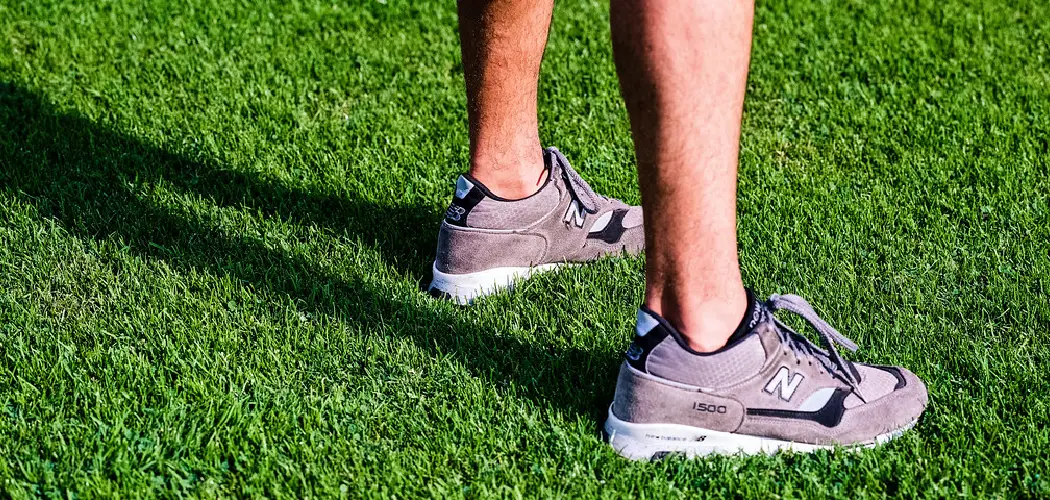Turf shoes seem to be the perfect option for athletes who want the stability and traction of cleats without sacrificing the versatility of a regular sneaker. However, there is some debate about whether turf shoes can be worn on grass without causing damage. In this article, we will explore can you wear turf shoes on grass as well as the pros and cons of wearing turf shoes on grass and let you decide what is best for you.
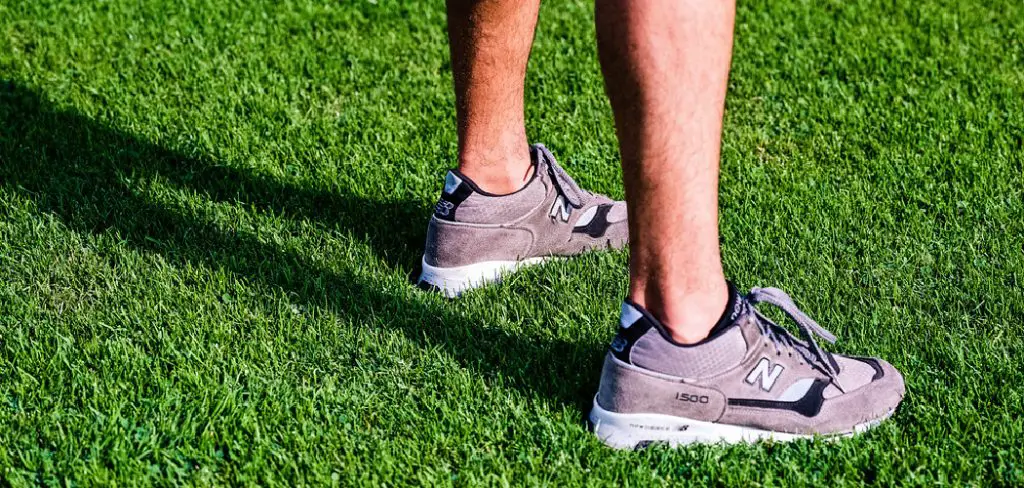
Turf shoes are designed with a rubber sole and cleats to provide stability and traction on artificial turf. The cleats are also designed to dig into the ground to provide better traction. This can be helpful when playing sports like soccer or football on an artificial surface. However, some people argue that wearing turf shoes on grass can cause damage to the grass.
What is the Truth Behind This Debate?
The truth is that wearing turf shoes on grass can be perfectly safe as long as the field is properly maintained. If the grass is well-watered and evenly cut, it should not cause any significant damage. However, if the grass is dry or uneven, the cleats on turf shoes can dig into the ground and create holes or divots, which may lead to an uneven playing surface and potential injuries.
Pros of Wearing Turf Shoes on Grass
Versatility
Unlike regular cleats, turf shoes can be worn on both artificial turf and grass surfaces. This makes them a more versatile option for athletes who play on different types of fields.
Comfort
Many athletes find that turf shoes are more comfortable to wear than traditional cleats. The rubber sole provides better cushioning and support, reducing the impact on the feet and joints during high-intensity movements.
Traction on Dry Grass
Turf shoes can provide better traction on dry grass compared to regular cleats. This is because the rubber sole grips onto the surface without causing damage, making it easier to make quick turns and changes in direction.
Cons of Wearing Turf Shoes on Grass
Potential Damage to the Field
As mentioned earlier, if the grass is not well-maintained, wearing turf shoes can potentially cause damage to the field. This can be a concern for schools or teams who have limited resources for field maintenance.
Lack of Ankle Support
Turf shoes do not provide as much ankle support as traditional cleats. This can be a disadvantage for athletes who need more stability and support while playing sports on grass.
Not Ideal for Wet Conditions
Turf shoes are not designed to be worn in wet conditions. The rubber sole does not provide enough traction on wet grass, making it difficult to run and change direction without slipping.
A Detailed Guide on Can You Wear Turf Shoes on Grass
Turf Shoes:
Turf shoes are a type of footwear designed on artificial turf. They typically have shorter, thicker cleats than those seen on traditional football or baseball cleats, providing better traction and stability on more complex surfaces.
There are a few reasons you might want to wear turf shoes on grass. First, if you play many sports that require quick starts and stops, such as basketball or tennis, the extra traction can help prevent slips and falls. Additionally, turf shoes can provide more support than regular cleats, which is essential for athletes with weak ankles or prone to rolled ankles. Finally, turf shoes tend to be lighter than cleats designed for natural grass, so they can be suitable for athletes who need to move quickly.
How to Choose Turf Shoes?
Turf shoes are specially designed shoes used to play on artificial turf. They have a rubber sole that provides good traction and protects your feet from the hard surface. Many people also use turf shoes on grass, as they offer better traction than regular sneakers. If you are looking for a pair of turf shoes, you should consider a few things.
– Fit: Turf shoes should fit snugly and not be too tight or too loose. They should also have comfortable arch support.
– Cleats: Most turf shoes have rubber or plastic cleats designed to grip the artificial turf surface. If you plan on using your turf shoes on grass, make sure the cleats are not too long, as they can damage the grass.
– Durability: Turf shoes need to be durable, as they will be subject to wear and tear. Look for a pair made from high-quality materials and has a good warranty.
– Traction: The sole of the turf shoe should provide good traction to move around easily on the artificial turf surface. If you plan on using your turf shoes on grass, make sure the sole has good traction.
– Height: Turf shoes come in different heights. Choose a comfortable pair for you and provides the right amount of support.
– Weight: Turf shoes are usually heavier than regular sneakers. If you plan on using your turf shoes on grass, make sure you choose a pair that is not too heavy.
Turf shoes are an excellent choice for anyone who plays sports on artificial turf or grass. They provide good traction and protect your feet from the hard surface. When choosing a pair of turf shoes, consider the fit, cleats, durability, and traction.
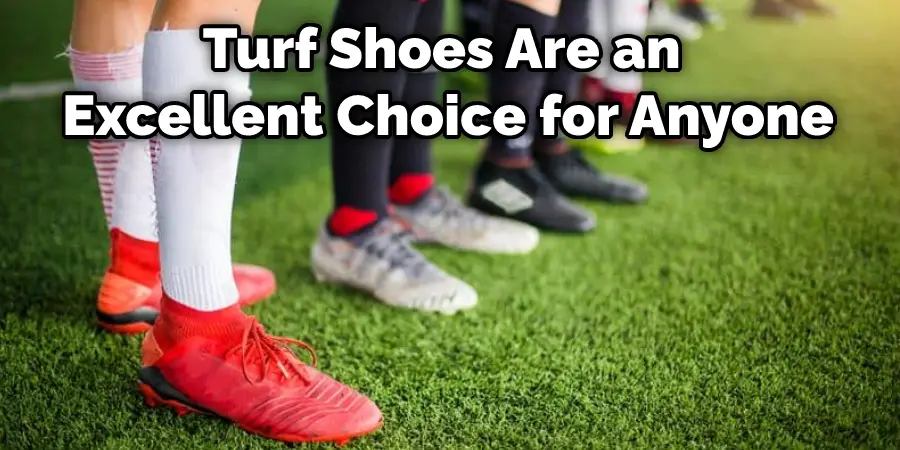
Wearing turf shoes on grass is perfectly fine and will not damage the shoes. Many athletes prefer to wear turf shoes on grass because they provide better traction than traditional sneakers. However, it is essential to keep in mind that turf shoes are not designed for running long distances on grass, so you may want to consider wearing a different type of shoe if you plan on doing this.
Difference Between Turf & Grass Cleat Shoes
The main difference between turf and grass shoes is the type of cleats or spikes on the bottom. Turf shoes have more minor, shorter cleats designed to provide traction on artificial turf surfaces, while grass shoes have longer cleats that can grip natural grass surfaces more effectively. Depending on the sport you play, you may need either type of shoe — or you might be able to get away with wearing sneakers.
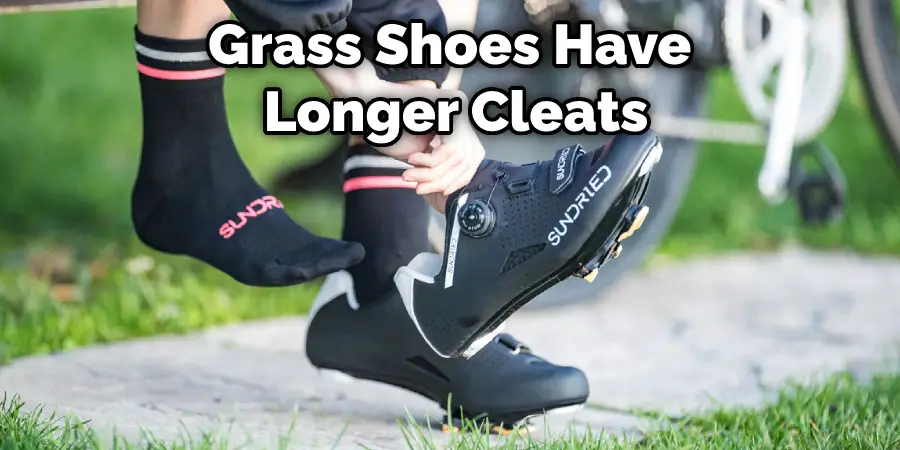
Knowing when to wear each type of shoe can help prevent injuries and improve your game. For example, if you wear turf shoes on grass, the shorter cleats may not provide enough traction, which could cause you to slip and fall. On the other hand, if you wear grass shoes on turf, the longer cleats could get caught in the turf and cause you to trip.
In general, it’s best to stick with turf shoes for artificial surfaces and grass shoes for natural surfaces. However, some hybrid shoes are now available that can be used on both types of surfaces. If you’re unsure which kind of shoe to wear, ask your coach or another expert on the sport. Ultimately, it is up to you to decide what is best for you.
Things to Consider When Wearing Turf Shoes on Grass
Wearing turf shoes on grass is something you might want to consider if you are an athlete who often plays on both surfaces. Turf shoes are designed with special spikes or cleats that offer extra traction and stability on artificial turf surfaces. However, these same features can also make turf shoes less than ideal for use on natural grass.
Before deciding whether or not to wear turf shoes on grass, there are a few things that you should take into consideration. First, consider the type of grass that you will be playing on. If the grass is soft and lush, you might be able to get away with wearing turf shoes without doing any damage. However, if the grass is dry and brittle, the spikes or cleats on your turf shoes could damage the surface.
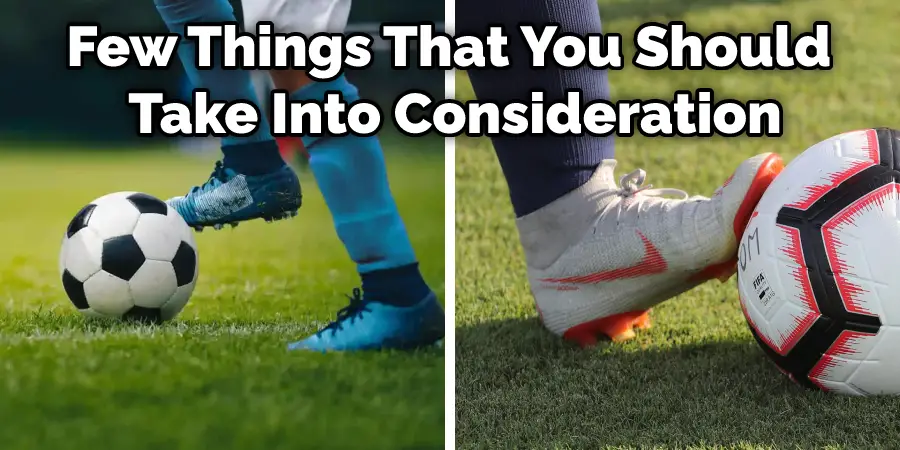
Another thing to consider is the condition of the artificial turf surface. If the surface is wet or muddy, wearing turf shoes will only worsen things. The spikes or cleats on turf shoes can often cause a lot of traction in wet environments, leading to slipping and falls.
Overall, whether or not you should wear turf shoes on grass depends on various factors. If you are unsure whether it is safe to do so, it might be best to err on the side of caution and use regular sneakers instead. This information will help in understanding can you wear turf shoes on grass.
Cleaning Turf Shoes After Using them on Grass
If you have ever worn turf shoes on a grass surface, they can get pretty dirty. The grass will often stick to the shoes, making them difficult to clean. While some methods can be used to clean the shoes, it is essential to understand which ones work best.
The following are three methods that can be used to clean turf shoes after using them on a grass surface:
1. Soak the Shoes in Water
One way to clean turf shoes is by soaking them in water. This method works best if the boots are still wet from wearing them on the grass. Add some soap to the water and soak the shoes for about 30 minutes. Afterward, use a brush to scrub the shoes and remove any dirt or grass sticking to them.
2. Use a Vacuum Cleaner
Another way to clean turf shoes is by using a vacuum cleaner. This method works best if the shoes are dry. Attach the vacuum cleaner’s hose to the nozzle and turn it on. Turn the vacuum cleaner to its highest setting and hold it about six inches away from the shoes. The suction from the vacuum cleaner will pull any dirt or grass off of the shoes.
3. Use a Brillo Pad
The third way to clean turf shoes is by using a Brillo pad. This method works best if the shoes are still wet from wearing them on the grass. Add some soap to the Brillo pad and scrub the shoes. Be sure to scrub all of the dirt and grass off of them and any other stains.
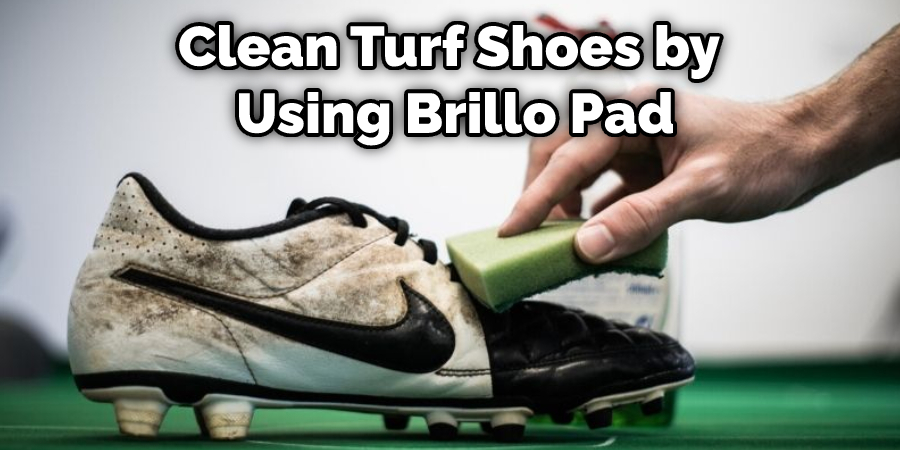
No matter which of these methods you choose to use, clean the shoes thoroughly. This will help keep them looking good and prevent any grass or dirt from sticking to them in the future.
Are There Any Downsides to Wearing Turf Shoes on Grass?
There are a few potential downsides to wearing turf shoes on grass.
First, turf shoes may not provide as much traction as regular shoes on wet grass. This can be dangerous if you’re playing sports or walking in an area prone to being slippery.
Second, the spikes on turf shoes can damage lawns and fields. So, if you’re going to be wearing turf shoes on grass, it’s essential to be aware of how your behavior could impact the surface below you.
Finally, turf shoes can be more expensive than regular shoes. So, if you’re looking for a versatile pair of shoes that can handle both concrete and grass, turf shoes might not be the best option.
Can You Wear Outdoor Cleats on Turf?
Wearing the wrong type of cleats on turf can damage the synthetic surface and cause injuries. Turf shoes have shorter, stubbier cleats designed to grip the synthetic fibers of turf fields. Outdoor cleats have longer, more pointed cleats meant to penetrate natural grass and provide traction. If you wear outdoor cleats on turf, the long spikes can get caught in the synthetic material and rip it up. This can create divots and uneven surfaces that can trip players and lead to injuries. It’s best to stick to turf shoes when playing on artificial turf.
Can You Wear Turf Shoes as Normal Shoes?
Turf shoes, also known as soccer shoes, are specifically designed for playing soccer on artificial surfaces. However, there is some debate over whether or not they can be worn as regular shoes on grass. Some people say that the spikes on the turf shoes will damage the grass, while others argue that the shoes are no different from other types of sneakers and can be worn without causing any damage.
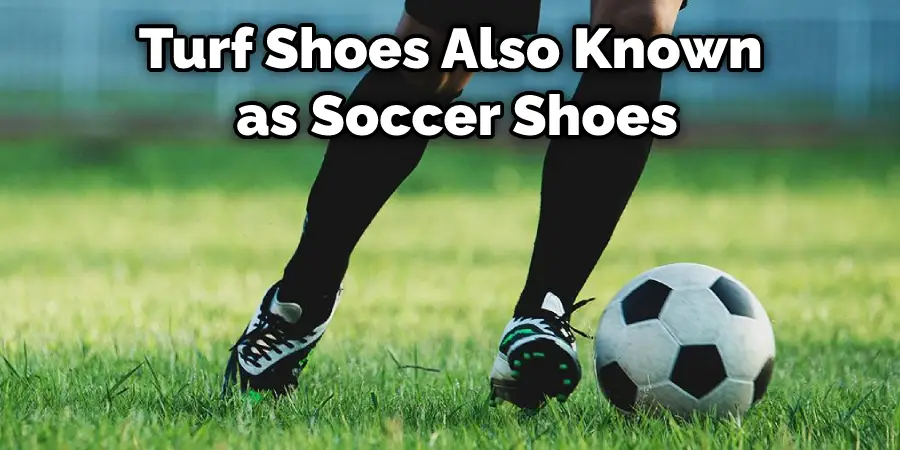
So, what’s the verdict? Can you wear turf shoes on grass or not? In short, it depends. If you’re only going to be walking on grass and not playing soccer or any other sport that would require you to wear turf shoes, then it’s probably okay to wear them. However, if you plan to run or do any other activities that may damage the grass, it’s best to stick with regular sneakers.
Frequently Asked Questions:
Q: Can I Wear Turf Shoes on My Lawn at Home?
A: Yes, you can wear turf shoes on your lawn at home. However, be aware that the spikes or cleats on the turf shoes may damage the grass. You may want to consider using regular sneakers instead. It’s also a good idea to check with your homeowner’s association or landlord before wearing turf shoes on your lawn to avoid any potential conflicts. You can also take precautions, such as avoiding wearing turf shoes when the grass is wet or using a different cleaning method to prevent damage.
Q: Can I Wear Turf Shoes on Natural Grass Fields?
A: It’s not recommended to wear turf shoes on natural grass fields. The longer, more pointed cleats on outdoor cleats are designed for natural grass and can cause damage to the synthetic fibers of turf fields. If you’re playing sports on natural grass, it’s best to use outdoor cleats specifically designed for that surface. You can also ask the field manager or coach for their recommendation on appropriate shoe wear.
Q: How Often Should I Replace My Turf Shoes?
A: It’s recommended to replace your turf shoes every 3-4 months if you use them regularly. Over time, the spikes or cleats may wear down, and the grip will decrease, making it less effective for playing on turf surfaces. Replacing your turf shoes regularly will help maintain their performance and prevent injury. It’s also essential to clean and dry your turf shoes after each use to prolong their lifespan.
Q: Can I Use Turf Shoes for Other Sports Besides Soccer?
A: While turf shoes are primarily designed for playing soccer on artificial surfaces, they can also be used for other sports that require quick movements and traction, such as lacrosse or field hockey. However, it’s essential to consult with your coach or trainer to ensure that the turf shoes are suitable for the specific sport and surface you will be playing on.
Q: Can I Wear Turf Shoes Indoors?
A: Yes, turf shoes can also be worn indoors on gym floors or other hard surfaces. They provide good traction and grip, making them suitable for activities such as weightlifting or indoor soccer. Just be sure to clean the shoes thoroughly before wearing them on a different surface, as dirt and debris from outdoor use can damage indoor floors. You may also want to consider purchasing separate turf shoes specifically for indoor use to prevent any potential damage to your outdoor turf shoes.
Conclusion:
While turf shoes can be worn on grass, they may not be the best choice for your needs. Consider the surface you will be playing on and how significant traction is to you before purchasing. Turf shoes are an excellent option for those who play sports on artificial surfaces but may not provide enough grip for those playing outdoors. We hope now you know can you wear turf shoes on grass. Thanks for reading!
You Can Check It Out to Why Crocs Are So Expensive?
You May Also Read: Is It Ok to Wear Running Shoes for Walking?

